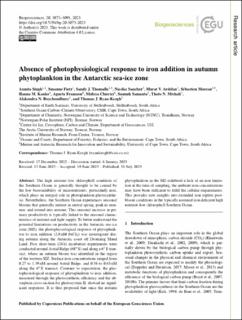| dc.contributor.author | Singh, Asmita | |
| dc.contributor.author | Fietz, Susanne | |
| dc.contributor.author | Thomalla, Sandy J. | |
| dc.contributor.author | Sanchez, Nicolas | |
| dc.contributor.author | Ardelan, Murat V. | |
| dc.contributor.author | Moreau, Sebastian | |
| dc.contributor.author | Kauko, Hanna Maria | |
| dc.contributor.author | Fransson, Agneta | |
| dc.contributor.author | Chierici, Melissa | |
| dc.contributor.author | Samanta, Saumik | |
| dc.contributor.author | Mtshali, Thato N. | |
| dc.contributor.author | Roychoudhury, Alakendra N. | |
| dc.contributor.author | Ryan-Keogh, Thomas J. | |
| dc.date.accessioned | 2023-09-01T10:55:40Z | |
| dc.date.available | 2023-09-01T10:55:40Z | |
| dc.date.created | 2023-08-25T11:09:29Z | |
| dc.date.issued | 2023 | |
| dc.identifier.citation | Biogeosciences. 2023, 20 3073-3091. | |
| dc.identifier.issn | 1726-4170 | |
| dc.identifier.uri | https://hdl.handle.net/11250/3087003 | |
| dc.description.abstract | he high nutrient–low chlorophyll condition of the Southern Ocean is generally thought to be caused by the low bioavailability of micronutrients, particularly iron, which plays an integral role in phytoplankton photosynthesis. Nevertheless, the Southern Ocean experiences seasonal blooms that generally initiate in austral spring, peak in summer, and extend into autumn. This seasonal increase in primary productivity is typically linked to the seasonal characteristics of nutrient and light supply. To better understand the potential limitations on productivity in the Antarctic sea-ice zone (SIZ), the photophysiological response of phytoplankton to iron addition (2.0 nM FeCl3) was investigated during autumn along the Antarctic coast off Dronning Maud Land. Five short-term (24 h) incubation experiments were conducted around Astrid Ridge (68∘ S) and along a 6∘ E transect, where an autumn bloom was identified in the region of the western SIZ. Surface iron concentrations ranged from 0.27 to 1.39 nM around Astrid Ridge, and 0.56 to 0.63 nM along the 6∘ E transect. Contrary to expectation, the photophysiological response of phytoplankton to iron addition, measured through the photosynthetic efficiency and the absorption cross-section for photosystem II, showed no significant responses. It is thus proposed that since the autumn phytoplankton in the SIZ exhibited a lack of an iron limitation at the time of sampling, the ambient iron concentrations may have been sufficient to fulfil the cellular requirements. This provides new insights into extended iron replete post-bloom conditions in the typically assumed iron deficient high nutrient–low chlorophyll Southern Ocean | |
| dc.description.abstract | Absence of photophysiological response to iron addition in autumn phytoplankton in the Antarctic sea-ice zone | |
| dc.language.iso | eng | |
| dc.title | Absence of photophysiological response to iron addition in autumn phytoplankton in the Antarctic sea-ice zone | |
| dc.title.alternative | Absence of photophysiological response to iron addition in autumn phytoplankton in the Antarctic sea-ice zone | |
| dc.type | Peer reviewed | |
| dc.type | Journal article | |
| dc.description.version | publishedVersion | |
| dc.source.pagenumber | 3073-3091 | |
| dc.source.volume | 20 | |
| dc.source.journal | Biogeosciences | |
| dc.identifier.doi | 10.5194/bg-20-3073-2023 | |
| dc.identifier.cristin | 2169595 | |
| cristin.ispublished | true | |
| cristin.fulltext | original | |
| cristin.qualitycode | 1 | |
